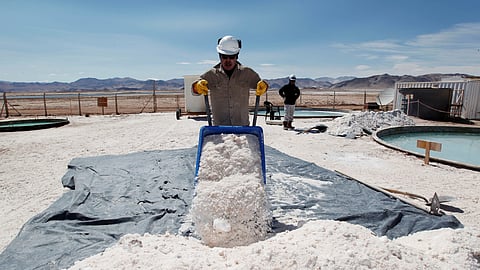

The government announced last week that for the first time, 5.9 mn tonnes inferred resources (G3) of lithium had been discovered in the country in Jammu and Kashmir.
The non-ferrous metal is a key component in the manufacturing of batteries for electric vehicles. The exploration led by the Geological Survey of India found the reserves in Reasi district of J&K, which has piqued the curiosity of stakeholders in the EV ecosystem.
The Ministry of Mines had said that in order to energise the critical supply chain of minerals for emerging technologies, the government was embarking on proactive initiatives to secure minerals, including importing lithium from nations like Australia and Argentina.
Currently, India is heavily dependent on imports from other nations for minerals like lithium, cobalt and nickel, which are essential for making everything from solar panels to laptops, smartphones, EV batteries and more.
Lithium, the lightest metal, is characterised by its scarcity. As per the US Geological Survey, lithium is more abundant than metals like tin and silver. However, its occurrence is mostly seen in rocks as a trace element. Being highly reactive, lithium is never found in nature as a metal. As of 2022, its total global reserves were estimated to be 80 mn tonnes.
However, it might be noted that the reserves from which lithium can be accessed, were estimated to be about 22 mn tonnes. Share wise, Chile holds the top spot with 9.2 mn tonnes, followed by Australia with 5.7 mn tonnes and Argentina with 2.2 mn tonnes.
The rider in the Indian discovery is the fact that the presence of the mineral was inferred from geological evidence. However, these reserves have not been assessed for viability. Experts say that inferred resources imply that these are at an initial stage of examination, and factors such as tonnage, grade, and mineral constituents can only be estimated with minimal surety. The confidence levels, vis-a-vis the availability of a mineral is measured in terms of G1, G2 and G3. With regard to India, the discovery of reserves have been mainly categorised under G4, which is indicative of the finds being in an exploratory phase.
It’s not yet time for India to pop the champagne. Our domestic manufacturing bandwidth of lithium-ion batteries (LiB) is quite limited. Consider the total cost of a LiB, and the cell accounts for 65% of it. The remainder is split between the battery pack (15%), the battery management system (15%) and finally the outer casing. India’s proficiency is currently limited to the latter two segments, essentially the subcomponents of the battery packs.
The demand for such batteries will increase at a CAGR of 52.5% by 2030. The government is also keen on pushing EVs to make up at least 30% of all new automobile registrations by 2030. But, it must be remembered that extraction of lithium comes at a cost. The pitfalls include degradation of soil, excessive use of water resources, loss of biodiversity, extensive damage to functioning of natural ecosystems and of course, an increase in global warming. Let’s not forget the plight of thousands of workers employed in cobalt mines in Congo, which has prompted questions of rampant violations of human rights in pursuit of global goals of sustainability. For India, it’s going to be a tall order, racing on the road to net zero versus ensuring it does so, without upsetting the natural balance of things.
Visit news.dtnext.in to explore our interactive epaper!
Download the DT Next app for more exciting features!
Click here for iOS
Click here for Android